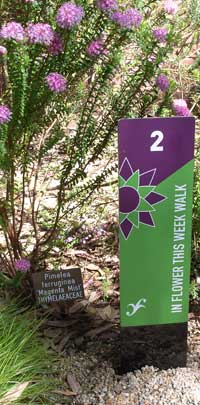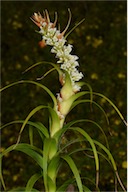In Flower This Week
A news sheet prepared by a Gardens' volunteer.
Numbers before each plant refer to temporary IFTW labels in the gardens.
Numbers in square brackets [ ] refer to garden bed Sections. Plants in flower are in bold type.
View past issues of 'In Flower This Week'.
28 October 2015
Dracophyllum oceanicum click for larger image |
Only a short walk today, as there are so many flowers in bloom.
- Turn right as you exit the Visitor Information Centre (VIC) to see on your right two pots of Platytheca galioides [Section 221]. This plant, native to southwestern Western Australia, has fine foliage and deep purple bell flowers with dark red centres.
- On your left in a pot is Dracophyllum oceanicum [Section 210], with red stems, curved stiff foliage and white terminal flower clusters. This plant occurs in the wild in a restricted area around Jervis Bay in New South Wales.
- Further on your right is Kennedia macrophylla [Section 174], a vine with soft green trifoliate leaves and orange/red pea flowers. This plant is rare and endangered and is found only in the Augusta-Cape Leeuwin area of coastal southern Western Australia.
- On your left is Alyogyne huegelii ‘West Coast Gem’ [Section 210], with clear purple “hibiscus”-like flowers, which open for a short period only but are prolific. The shrub is medium-sized with coarse foliage.
- On your right is Epacris longiflora [Section 174], with long thin tubular white flowers on a straggly light green bush. This species belongs to the heath family and its native range extends from the central coast of New South Wales to southern Queensland.
- Further on your right in a pot is Hibbertia stellaris [Section 174], or Orange Stars, with masses of orange star flowers on wiry foliage. This brilliantly-flowering groundcover from southern Western Australia grows naturally in swamps.
- Also on your right is a group of Pimelea rosea ‘Deep Dream’ [Section 174], with rounded heads of deep mauve-pink tubular flowers on a small plant with greyish-green foliage.
- On your right as you cross the bridge is Olearia argophylla [Section 66], commonly called Musk Daisy Bush or Native Musk. It is a tall shrub or small tree with felted grey leaves and white, strongly-scented flowers. It is an east coast species and grows naturally in New South Wales, Victoria and Tasmania
- Go past the café and bear right towards the Crosbie Morrison Building to see in a pot on your left Chamelaucium uncinatum ‘Purple Pride’ [Section 240], a small bush with needle foliage and deep purple “wax” flowers.
- Also in the same pot on your left is Boronia ‘Purple Jared’ [Section 240], with green foliage and deep purple bell flowers.This cultivar is a cross between Boronia megastigma and B. heterophylla.
- On your left is Grevillea ‘Bonfire’ [Section 240], a tall bush with fine dark green needle foliage and many clusters of red flowers. This plant is a hybrid between Grevillea johnsonii and G. wilsonii.
- Grevillea ‘Winpara Gold’, [Section 240] on your left is a medium-sized bush with fine foliage and pink and yellow pendent clusters of flowers. It is a possible hybrid, which arose as a seedling at "Winpara", near Jervois, South Australia.
- Look to your right to see Petrophile biloba [Section 240], or Granite Petrophile, an upright shrub with upward-pointing green foliage and large yellow cone flowers. It is native to southwestern Western Australia.
- On your right is Philotheca myoporoides [Section 240], beloved by bees and hoverflies. It is a neat shrub with dull green foliage, pink buds and white star flowers and is endemic to south-eastern Australia.
- On your left is Commersonia magniflora [Section 240], a medium-sized bush with a strong scent covered in white flowers fading to pink. This plant is from central and western Australia.
Rosalind Walcott
![Director of National Parks [logo]](../../../../images/dnp_90px.gif)







